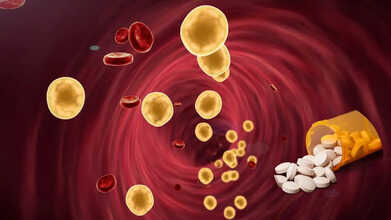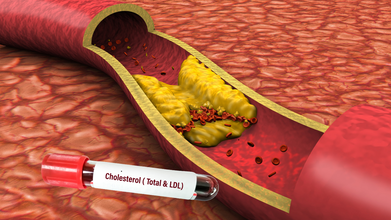- Health Conditions A-Z
- Health & Wellness
- Nutrition
- Fitness
- Health News
- Ayurveda
- Videos
- Medicine A-Z
- Parenting
Hormone Therapy For Menopause No Longer Carries a ‘Black Box’ Safety Warning — What Does This Mean?

Credits: Canva
Hormone Replacement Therapy: The U.S. FDA has announced it will remove the long-standing black box safety warnings from all hormone replacement therapy (HRT) products used to manage menopause and perimenopause symptoms. The move comes after new evidence suggested that earlier studies overstated the risks of heart disease, stroke, and cancer linked to HRT.
The U.S. Food and Drug Administration (FDA) has announced that it will remove the black box safety warnings from all forms of hormone replacement therapy (HRT)—including creams, pills, and other treatments used to manage menopause and perimenopause symptoms.
The warnings, which appeared on labels for over two decades, suggested that these therapies could increase the risk of cancers, dementia, heart disease, and strokes. However, FDA Commissioner Dr. Marty Makary told CBS News that those cautions likely discouraged many women from using treatments that might actually improve their long-term health.
“We now have a more nuanced understanding,” Dr. Makary said, as per CNN News. He further said, “We want to put that fear in context and let people know that there are tremendous long-term health benefits.”
Hormone Replacement Therapy: What Is It?
HRT, or Hormone Replacement Therapy, is a treatment that helps restore hormones the body no longer produces in sufficient amounts. It is most often prescribed to ease menopause symptoms such as hot flashes by supplementing estrogen and progesterone, the hormones that naturally decline during this stage. According to the NHS, HRT may also be recommended for other hormonal deficiencies, including those caused by thyroid or pituitary gland disorders.
Hormone Replacement Therapy: What Does Removing the Black Box Safety Warning Mean?
Removing the black box warning signals a significant shift in how hormone replacement therapy is viewed by regulators and the medical community. The decision suggests that the potential benefits of properly prescribed HRT now outweigh the earlier perceived risks.
It also means that doctors may feel more confident recommending these treatments for women struggling with menopause symptoms such as hot flashes, mood changes, and vaginal dryness—especially when therapy is started around the time of menopause rather than years later.
However, experts still stress that hormone replacement therapy is not one-size-fits-all. Women should discuss their personal and family medical history with their doctor to decide whether HRT is the right choice for them.
Hormone Replacement Therapy: Why Hormone Replacement Therapy Had the Warning?
In 2002, the landmark Women’s Health Initiative study linked hormone therapy to higher rates of breast cancer and stroke, prompting the FDA to issue the now-familiar black box warning—the strongest alert it can give.
But since then, newer research has challenged those early conclusions. Studies now show that hormone replacement therapy, particularly when started early, may reduce the risk of heart disease, improve bone health, and even protect against cognitive decline.
This shift in scientific understanding pushed many doctors to call for the warning’s removal, arguing that the outdated label created unnecessary fear and confusion among women seeking menopause relief.
Hormone Replacement Therapy: How the FDA Reached Its Decision
As per USA Today, in July, the FDA organized an expert panel to evaluate whether the warnings should remain, especially for low-dose vaginal estrogen products. After the meeting, the agency opened a public comment period and received nearly 3,000 responses by late September.
The American College of Obstetricians and Gynecologists (ACOG) has long supported reviewing the label on low-dose vaginal estrogen, which acts locally rather than systemically. However, ACOG also raised concerns that the July panel lacked the depth and transparency of a standard FDA advisory committee meeting.
“A two-hour expert panel should not replace a full advisory committee discussion,” ACOG stated in its formal comment, urging the FDA to hold separate, detailed reviews for vaginal and systemic hormone therapy options.
Despite these reservations, the FDA shared several supporting studies, including evidence that hormone replacement therapy can reduce the risk of Alzheimer’s disease, heart attack, and hip fractures. Many of these findings date back to research published between the 1980s and early 2000s.
The FDA’s decision to drop the black box warning from menopause-related hormone treatments marks a turning point in women’s health care. As research continues to clarify the true risks and benefits of hormone replacement therapy, the move could help many women make more informed and less fearful decisions about managing menopause safely and effectively.
Can’t Control Cholesterol With Statins? Scientists Say A New Experimental Pill Shows Strong Results

Credits: Canva
For many people living with high cholesterol, diet changes and daily statin therapy may not be enough to hit their target levels. A new experimental pill, however, could provide an additional option for those struggling to control their low-density lipoprotein (LDL), or “bad,” cholesterol.
Recent Phase 3 trial data revealed that participants who took the investigational drug ‘enlicitide’ alongside their usual cholesterol-lowering treatment saw reductions in LDL cholesterol of up to 60% after 24 weeks. This was compared to participants who continued their standard therapy with a placebo. The study included adults with elevated LDL and either a history of major cardiovascular events or an increased risk of such events, as per CNN.
The results, which have not yet appeared in a peer-reviewed journal, were shared at the American Heart Association’s Scientific Sessions.
High LDL cholesterol contributes to plaque buildup in arteries, which can increase the risk of heart disease, which is the leading cause of death in the U.S., with a fatality occurring roughly every 34 seconds.
New Daily Pill May Cut Bad Cholesterol By 60%
Merck, the company behind enlicitide, intends to apply for FDA approval early next year, according to Dr. Puja Banka, associate vice president of clinical research and global clinical development.
“We aimed to see what enlicitide could achieve on top of statins, because about 70% of patients on lipid-lowering therapy still don’t reach guideline-directed targets,” said Banka.
When Statins Alone Are Not Enough
The trial enrolled 2,912 adults, averaging 63 years old, who had previously suffered a heart attack or stroke or were at medium-to-high risk for one over the next decade. Data was collected across 14 countries between August 2023 and July 2025.
All participants had elevated LDL levels despite at least 30 days on stable lipid-lowering therapy, mostly statins. About 97% were on statins, and 26% were taking another cholesterol-lowering medication. During the trial, some participants were given enlicitide once daily, while others received a placebo, as per CNN.
Enlicitide belongs to a class of drugs called PCSK9 inhibitors, which work by helping the body clear LDL cholesterol from the bloodstream. Statins, by contrast, block a liver enzyme to increase LDL removal.
“Because enlicitide works differently from statins, it’s expected to further lower LDL cholesterol when used in combination,” explained Dr. Kristin Newby, a cardiologist at Duke University School of Medicine, who was not involved in the trial.
As per CNN, after 24 weeks, participants on enlicitide experienced sustained LDL reductions through 52 weeks, along with:
- A 53% drop in non-HDL cholesterol
- A 50% decrease in ApoB, a protein that carries harmful cholesterol in the body
- A 28% reduction in lipoprotein(a), a type of fat linked to heart disease
Safety and Side Effects
Around 10% of participants on enlicitide experienced serious adverse events, compared with 12% in the placebo group. Side effects were generally balanced between both groups, with no particular event standing out. Reported issues included gastrointestinal symptoms and certain infections.
“This suggests no major or frequent safety concerns,” said Newby, as per CNN. “However, larger, long-term studies and post-marketing surveillance will be needed to monitor for rarer side effects. The key takeaway is that enlicitide is highly effective at lowering LDL cholesterol—about 55% more than placebo when added to statins—and helps more people reach treatment goals.”
A New Option for Cholesterol Management
For patients who don’t fully respond to statins, injectable PCSK9 inhibitors are already available. But unlike those treatments, enlicitide is an oral daily pill, offering an easier administration route that some patients may prefer. Banka called it “the first oral PCSK9 inhibitor to complete Phase 3 trials.”
Previously, studies have shown that injectable PCSK9 inhibitors, like evolocumab (Repatha), can reduce the risk of first-time major cardiovascular events in adults with atherosclerotic cardiovascular disease or diabetes. In trials across 33 countries, 12,257 adults taking evolocumab for an average of 4.6 years saw a 25% reduction in heart attack, stroke, or coronary deaths compared with placebo. The FDA has already approved evolocumab for patients with established cardiovascular disease or as an add-on therapy for high cholesterol.
The new enlicitide trial marks the first demonstration of a non-statin PCSK9 inhibitor improving cardiovascular outcomes in patients without a prior heart attack or stroke who were already on intensive lipid-lowering therapy.
Breakthrough: Gene Editing Jab Dramatically Lowers Harmful Cholesterol Levels In First Trial

Credits: Canva
It may sound unreal, but by just altering one gene could one day help many people to permanently lower their dangerously high cholesterol and blood fat levels. This is the biggest takeaway from the latest research which had been unveiled at the American Heart Association's annual meeting in New Orleans.
The early stage human trial tested a first of its kind CRISPR based therapy, and the results were way better and way more powerful than what the cardiologists had expected.
What Is This Experimental Treatment All About?
The Phase 1 trial involved 15 adults, all with severely high levels of LDL cholesterol, or the bad cholesterol. They also had high triglycerides, some had both. The main goal of the experiment was not to prove whether the drug would improve health, but to confirm if it is safe enough to be tested in humans.
Dr Steven Nissen of the Cleveland Clinic, one of the study investigators, admitted he never imagined such a treatment would be possible. “The results were pretty spectacular,” he said.
Researchers say it passed that initial test. Even more striking, a single infusion of the gene editing therapy reduced LDL (the “bad” cholesterol) and triglycerides by around 50 percent. That kind of drop could sharply reduce a patient’s lifetime risk of heart attack and stroke.
How Does Gene Editing Work?
This treatment uses a gene editing tool called CRISPR. This tool can cut and alter DNA. This is thus able to target a single liver gene called ANGPTL#. While usually this gene boosts cholesterol levels by blocking the liver's ability to break down fats, some people may have naturally versions of this gene that do not work as strongly, and thus give them low cholesterol levels their entire lives.
The experimental drug is designed to mimic that natural advantage by turning off the gene permanently. Unlike statins, which must be taken daily, this therapy aims to work after just one dose. The drug, CTX310, was developed by CRISPR Therapeutics, which also funded the trial.
Excitement, But With Caution
The findings, which were simultaneously published in The New England Journal of Medicine, sparked a mix of enthusiasm and hesitation among heart experts.
Dr Karol Watson of UCLA called it an important proof of concept, but emphasized that permanent gene changes require long term safety data. “We already have safe, effective medications,” she said. “CRISPR must prove it’s both effective and safe over the long haul.”
Others note that many patients stop taking statins due to side effects, meaning a one time alternative could eventually fill a real need. Still, doctors stress that such a therapy must be studied for years before it becomes a mainstream option.
How Was The Study Conducted?
Most participants in the study were in their 50s or 60s, and lived in Australia, New Zealand, and in the UK. They received a single IV infusion lasting up to four and four and a half hours. Side effects were mild and temporary: nausea, back pain, and one brief increase in liver enzymes. One participant died months later from an unrelated cause.
Those who received the highest dose saw the biggest change. LDL levels fell by nearly 49 percent and triglycerides dropped by about 55 percent within two months.
Experts like Dr Elizabeth McNally of Northwestern say the dual effect on both LDL and triglycerides is promising, especially for people with very high triglycerides. Still, she cautioned that researchers must prove the therapy offers clear advantages over existing treatments.
Sally Kirkland Enters Hospice After Enduring 'A Challenging Few Months'

Credits: Wikimedia Commons
Sally Kirkland, American actress and producer has now entered hospice care in Palm Springs. The news was confirmed on November 9 by her rep Michael Greene, as per TMZ. The same was also updated on her GoFundMe page.
The November 7 post read from the account's manager read: "Thank you for all your love and support. Sally is grateful for your kindness and love. Sally is on hospice now and is resting comfortably. Please hold and send the light for Sally."
Also Read: Can Breathing Polluted Air Affect Blood Sugar During Pregnancy?
This update has come just over a month after organizers shared that Sally, who is now 84, had endured "a challenging few months".
What Happened To Sally?
On October 2, an update read: "Hi: Sally sends her love to everyone. It has been a challenging few months for Sally as her health continues to struggle. She had a fall in the shower, when she was left unattended, injuring her ribs and foot, along with cuts and bruises. Sally is now receiving 24/7 care in a specialized facility that is providing wonderful safety and care. We are continuing to raise money to cover the gaps between income and care costs. Thank you for all the love, support, and care for Sally."
Sally's fundraiser was created in November 2024, after Sally "fractured her four bones in neck, right wrist, and her left hip" and while she was recovering, she had developed "two separate life-threatening infections". Her medical bills would mount more than her insurance could cover.
She also created a video shortly after her GoFundMe account was made where she thanked everyone who donated. "Everyone, I just wanted to thank you for sending me your love and your light and helping me get through this, day by day, helping me with my GoFundMe page. It really touches my heart. [I] really feel your love."
What Is A Hospice?
Hospice is a specialized care focused on the comfort and quality of life for people with serious illnesses near the end of life. This happens typically when a cure is not possible. It provides physical, emotional, and spiritual support for the patient, as well as for their family. The hospice also aims to manage pain and symptoms, rather than focusing on life-prolonging treatments. This care can be provided at home, in a hospice center, a hospital, or a nursing home.
Also Read: ByHeart Baby Formula Recalled As 10 US States Report 13 Cases Of Infant Botulism After Use
Why Do People Choose Hospice?
One of the key reasons why patients who have a degenerative condition choose hospice is because of the patient-centric care that it provides. A hospice has a team of professionals, including doctors, nurses, social workers, and chaplains, who provide a range of support to the patient and their loved ones. The care too is personalized to meet the needs of all individual patients, their needs, values, and preferences. The primary goal is to control their pain and other symptoms in order to maximize the patient's comfort and quality of life. There are also family-centered hospice that extends support to the family and loved ones of the patients, and help them cope with the illness and grief.
Hospice is typically used when a person has a prognosis of six months or less and has decided to stop treatment to cure or control their illness.
© 2024 Bennett, Coleman & Company Limited

